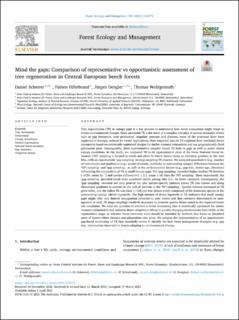Please use this identifier to cite or link to this item:
https://doi.org/10.21256/zhaw-22241| Publication type: | Article in scientific journal |
| Type of review: | Peer review (publication) |
| Title: | Mind the gaps : comparison of representative vs opportunistic assessment of tree regeneration in Central European beech forests |
| Authors: | Scherrer, Daniel Hiltebrand, Fabien Dengler, Jürgen Wohlgemuth, Thomas |
| et. al: | No |
| DOI: | 10.1016/j.foreco.2021.119179 10.21256/zhaw-22241 |
| Published in: | Forest Ecology and Management |
| Volume(Issue): | 491 |
| Issue: | 119179 |
| Issue Date: | 1-Apr-2021 |
| Publisher / Ed. Institution: | Elsevier |
| ISSN: | 0378-1127 1872-7042 |
| Language: | English |
| Subjects: | Tree recruitment; Switzerland; Canopy disturbance; Natural regeneration; National forest inventory; Gap dynamics; Temperate forests |
| Subject (DDC): | 333.7: Land, natural recreational areas |
| Abstract: | Tree regeneration (TR) in canopy gaps is a key process to understand how forest ecosystems might adapt to future environmental changes. Since successful TR is the result of a complex interplay of several stochastic events such as gap formation, seed production, ungulate pressure and diseases, some of the processes have been neglected or strongly reduced for model applications. Most empirical data on TR originate from (national) forest inventories based on statistically optimized designs for timber resource estimations and use geographically fixed permanent plots. Consequently, these representative samples record TR both in gaps as well as under closed canopy conditions. In this study, we compared TR in 63 representative plots of the Swiss National Forest Inventory (‘NFI sampling’), located in beech and silver fir-beech forests along an elevation gradient in the Jura Mts., with an opportunistic ‘gap sampling’ strategy targeting TR-clusters. We analyzed quantitative (e.g., number of individuals) and qualitative (e.g., species diversity, similarity to surrounding canopy) differences between the ‘NFI sampling’ and ‘gap sampling,’ as well as the environmental factors (e.g., gap size, cluster age, elevation) influencing the composition of TR in small canopy gaps. The ‘gap sampling’ recorded higher median TR densities (+62%, stems ha 1) and species richness (4.0 ± 2.1, mean ± sd) than the ‘NFI sampling’. More importantly, the ‘gap sampling’ provided much more consistent results among sites (i.e., 4x lower variance). Consequently, the ‘gap sampling’ revealed not only general but also species-specific patterns across TR size classes and along elevational gradients in contrast to the lack of patterns in the ‘NFI sampling’. Species richness decreased as TR grew taller, and the tallest TR size class (>130 cm) was almost solely comprised of the dominant species in the surrounding canopy (direct ingrowth). The high amount of direct ingrowth in TR indicates that small canopy gaps might offer only limited management potential to alter forests and that extensive disturbances or management at early TR stages (sapling) would be necessary to promote species better suited to the expected future site conditions. We raise the question of whether a forest monitoring that is statistically optimized for timber resource estimation is best suited to detect adaptation effects to quickly changing environments best visible at the regeneration stage, or whether forest inventory tools should be extended by methods that focus on disturbed parts of forests where changes and adaptations take place. We propose the implementation of an opportunistic gap-based monitoring of TR that essentially serves to identify the best forest management strategies (e.g. gap size, intervention intervals) in forests adapting to environmental change. |
| URI: | https://digitalcollection.zhaw.ch/handle/11475/22241 |
| Fulltext version: | Published version |
| License (according to publishing contract): | CC BY 4.0: Attribution 4.0 International |
| Departement: | Life Sciences and Facility Management |
| Organisational Unit: | Institute of Natural Resource Sciences (IUNR) |
| Appears in collections: | Publikationen Life Sciences und Facility Management |
Files in This Item:
| File | Description | Size | Format | |
|---|---|---|---|---|
| 2021_Scherrer-etal_Assessment-of-tree-regeneration.pdf | 2.1 MB | Adobe PDF |  View/Open |
Show full item record
Scherrer, D., Hiltebrand, F., Dengler, J., & Wohlgemuth, T. (2021). Mind the gaps : comparison of representative vs opportunistic assessment of tree regeneration in Central European beech forests. Forest Ecology and Management, 491(119179). https://doi.org/10.1016/j.foreco.2021.119179
Scherrer, D. et al. (2021) ‘Mind the gaps : comparison of representative vs opportunistic assessment of tree regeneration in Central European beech forests’, Forest Ecology and Management, 491(119179). Available at: https://doi.org/10.1016/j.foreco.2021.119179.
D. Scherrer, F. Hiltebrand, J. Dengler, and T. Wohlgemuth, “Mind the gaps : comparison of representative vs opportunistic assessment of tree regeneration in Central European beech forests,” Forest Ecology and Management, vol. 491, no. 119179, Apr. 2021, doi: 10.1016/j.foreco.2021.119179.
SCHERRER, Daniel, Fabien HILTEBRAND, Jürgen DENGLER und Thomas WOHLGEMUTH, 2021. Mind the gaps : comparison of representative vs opportunistic assessment of tree regeneration in Central European beech forests. Forest Ecology and Management. 1 April 2021. Bd. 491, Nr. 119179. DOI 10.1016/j.foreco.2021.119179
Scherrer, Daniel, Fabien Hiltebrand, Jürgen Dengler, and Thomas Wohlgemuth. 2021. “Mind the Gaps : Comparison of Representative Vs Opportunistic Assessment of Tree Regeneration in Central European Beech Forests.” Forest Ecology and Management 491 (119179). https://doi.org/10.1016/j.foreco.2021.119179.
Scherrer, Daniel, et al. “Mind the Gaps : Comparison of Representative Vs Opportunistic Assessment of Tree Regeneration in Central European Beech Forests.” Forest Ecology and Management, vol. 491, no. 119179, Apr. 2021, https://doi.org/10.1016/j.foreco.2021.119179.
Items in DSpace are protected by copyright, with all rights reserved, unless otherwise indicated.